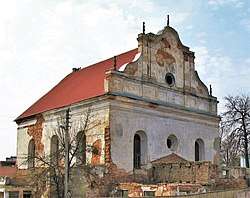Slonim Synagogue
The Great Synagogue of Slonim (Belarusian: Вялікая сінагога Слоніма) or simply the Slonim Synagogue (Belarusian: Слонімская сінагога) is a 17th-century baroque former synagogue building in Slonim, Belarus.
| Slonim Synagogue | |
|---|---|
 | |
| Status | Closed |
| Location | |
| Location | Slonim, |
| Geographic coordinates | 53°5′36.57″N 25°19′3.33″E |
| Architecture | |
| Type | Synagogue |
| Style | Baroque |
| Completed | 1642 |
| Website | |
| slonimsynagogue.org | |
History
The synagogue was the main religious building of Slonim's then numerous and influential Jewish community. The building was erected in 1642 and was initially part of the town's fortifications system.
In 1881 the synagogue was heavily damaged in a fire.
During the Second World War, almost the entire Jewish population of Slonim was murdered by the Nazis in the Holocaust. The building was left untouched by the German Luftwaffe during World War II, but has subsequently deteriorated. After the war, the Communist administration used the building as a furniture warehouse.[1]
In 2001, after the restoration of the independence of Belarus, the building was returned to the Belarusian Jewish community.
Current state
The synagogue is standing but in a dilapidated condition. It is listed by the private World Monuments Fund as their top priority site of Jewish interest in Eastern Europe that requires restoration.[2] British TV personality Natasha Kaplinsky was the subject of one of a series of BBC television programmes, Who Do You Think You Are?. Kaplinsky visited the synagogue, it having been the place of worship of her great-grandparents. Her cousin sang a lament in Hebrew in the synagogue.[3]
Restoration project
Under Kaplinsky's initiative, a steering group has been established under the auspices of the Foundation for Jewish Heritage to restore the Slonim Synagogue and to make it a “major educational facility, cross-cultural meeting place, memorial, place of worship, and a cultural centre ensuring that the Great Synagogue has a sustainable future”.[4] The steering group includes Britons and Americans with family links to the Jewish community of Slonim and the architect Tszwai So.[5]
Gallery
- Slonim Synagogue, 1975 painting by Valery Sliunchanka
_(4).jpg) Interiors of the synagogue before 1939
Interiors of the synagogue before 1939_(2).jpg) Interiors of the synagogue before 1939
Interiors of the synagogue before 1939.jpg) Interiors of the synagogue before 1939
Interiors of the synagogue before 1939.jpg) Slonim Synagogue, 1930 photo by the well-known Belarusian-Polish photographer, Jan Bulhak
Slonim Synagogue, 1930 photo by the well-known Belarusian-Polish photographer, Jan Bulhak
See also
- Anshe Slonim Synagogue in the Lower East Side of Manhattan, New York
- Slonim (Hasidic dynasty)
| Wikimedia Commons has media related to Synagogue in Slonim. |
References
- slonimsynagogue.org - History
- "Jews of Belarus Move to Save Their Past". Joanne Saltman. 1998. Archived from the original on 7 August 2007. Retrieved 11 September 2007.
- Wollaston, Sam (7 September 2007). "Last night's TV". London: The Guardian. Retrieved 7 September 2007.
- slonimsynagogue.org - Vision
- slonimsynagogue.org - People